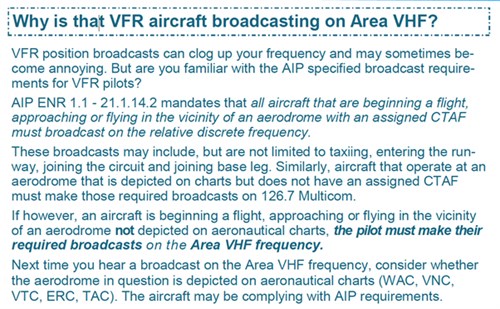The concern related to air traffic controllers advising pilots not to broadcast on the area frequency when they are operating at an aerodrome which is not marked on a map.
The reporter expressed a safety concern regarding the knowledge of air traffic controllers on the rules relating to broadcasts on the area frequency made by pilots approaching an aerodrome which is not marked on a map – AIP ENR 1.1 44.1.1 (c)
The reporter advised that general aviation pilots are being advised incorrectly by controllers not to make calls on the area frequency when they are making a broadcast that they are inbound or overflying an aerodrome which is not marked on a map. As this is coming from a perceived authority it is very confusing for general aviation pilots.
Reporter comment: It is apparent that generally ATS are not aware that broadcasts relating to non-charted aerodromes are now required to be made on the area VHF frequency. Perhaps ATS should be made aware of the potential disruption to ATS communications when this practice becomes widespread as it certainly will when the pilot community become fully aware of the requirement.
When the rules governing pilot broadcasts for airports not marked on maps were introduced in 2014, Airservices ensured that the standard change notification and awareness processes were followed.
Subsequently, to reinforce knowledge of the change amongst controllers, the issue was included as a focus area for Check and Standards Supervisor (CSS) as part of Focus Area Issue 5 in November 2014 and again in Issue 6 in March 2015.
Airservices also confirms that controllers are taught to expect aircraft to broadcast where applicable on the CTAF and/or Area frequency as part of Phase 2 of the enroute course in relation to Class G operations. Broadcasts, as a risk mitigation in Class G operations, is emphasised and trainees are taught to expect to hear broadcasts during training.
In reviewing the reported concern, Airservices will release further educational material to ensure that controllers are aware of their requirements. Airservices can provide the ATSB with this educational material following publication upon request.
CASA has reviewed the REPCON and notes the Airservices response and training and education provided to Air Traffic Controllers (ATC).
CASA also notes that there is no incident data from either ATSB or Airservices identifying or substantiating with evidence, a safety issue. CASA will continue to provide educational material on radio procedures outside controlled airspace to industry, and will continue to monitor radio procedures outside controlled airspace. If a safety issue is identified and substantiated with evidence CASA will act appropriately.
As part of the education and communication process, CASA has included material in the revised Visual Flight Rules Guide, hardcopy and online, placed articles on www.fsa.com and included where possible on all relevant safety promotion material e.g. OnTrack. CASA also intends to distribute additional ATC frequency awareness material to flying training schools, aero clubs, sport aviation organisations, and individuals in the near future.
Airservices Australia have advised that since our previous response dated 21 October 2015, Airservices has promulgated further educational material to ensure that controllers are aware of their requirements in relation to VFR aircraft broadcasting on area VHF.
Information provided to air traffic controllers:



